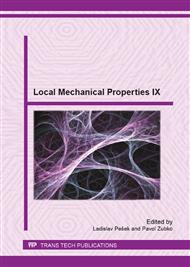p.87
p.91
p.96
p.100
p.104
p.108
p.112
p.116
p.120
Fatigue Cracking Processes of a Thick-Walled Component of a Chemical Pipeline
Abstract:
At present, there are no generally accepted and widely recognized procedures to determine condition of material of devices subject to complex long-term thermo-mechanical loads. Condition of pipeline material usually changes when subjected to the conditions of long-term operation. Its structure changes and, consequently, so do its mechanical properties, including fatigue characteristics and crack resistance. Therefore, the durability of a component operating under thermal and mechanical loads cannot be discussed separately from its current material properties. This applies in particular to changes that take place in the material micro-structure and to their connection with mechanical properties. This paper covers analyses of stress in the material of a selected pipeline component – pipe tee that is used in chemical plants. Thermo-mechanical interactions determining stress distribution in the component have been taken into account in the calculations. Morphology and location of the cracks indicated that a fatigue-like nature of impacts was the cause of material destruction. Loads of this type occur mainly in conditions of start-up and shut-down. For these reasons, condition of the material in the above-mentioned unstable conditions was subjected to numerical stress analysis. Due to geometric complexity of the pipeline, the distribution of stress in the T-pipe was calculated in two stages: the object was modeled from a global and local perspective. The resulting stress distributions helped to determine factors affecting durability of the tested object. Metallurgy tests were also conducted in order to ascertain factors determining the degradation of material structure and processes of crack formation and development. As a result of research one ascertained that the process of T-pipe cracking under operating conditions was a combined effect of thermo-mechanical and chemical actions determined by the course of intercrystalline corrosion. Synergic interaction of corrosion processes and variable thermal and mechanical loads caused nucleation and propagation of cracks. The crack systems in T-pipe areas subject to the highest stress showed courses characteristic for thermal fatigue of material. The results obtained will identify degradation mechanism of materials used in chemical installations.
Info:
Periodical:
Pages:
104-107
Citation:
Online since:
September 2013
Authors:
Keywords:
Price:
Сopyright:
© 2014 Trans Tech Publications Ltd. All Rights Reserved
Share:
Citation:


